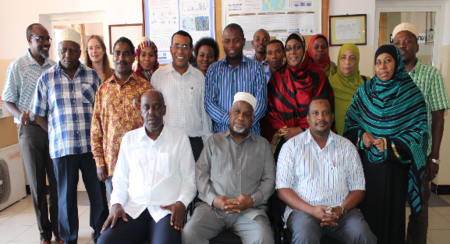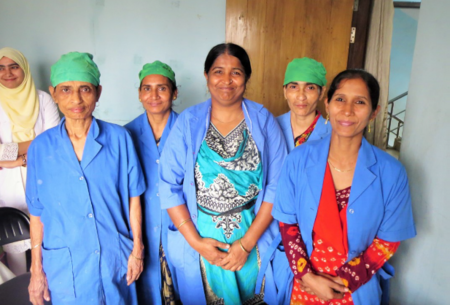Mission accomplished: how to design your NGO for redundancy

As The Soapbox Collaborative closes after achieving its mission of catalysing improved hygiene at birth in healthcare facilities in developing countries, its scientific leader Wendy Graham reflects on why size matters when you’re trying to make a difference.
After 30 years as an applied academic in obstetrics and epidemiology, I have just completed one of the most exciting and rewarding initiatives I have had the pleasure to lead – The Soapbox Collaborative. Reflecting on the lessons learned, many of these together with WaterAid, I find one recurring phrase in my mental musings – size matters.
Anthropometric phrases have featured prominently in my long career. For example, a common remark I receive from people from the same technical field meeting me for the first time is: “Oh – you are much smaller than I imagined you would be”! These incidents often leave me reflecting on the implications of size, and I now find myself applying a similar slide-rule to The Soapbox Collaborative.
Think big, act small
This small, evidence-based NGO was set up in March 2012 with the ambitious mission of catalysing improved hygiene at birth in healthcare facilities in low and middle-income countries. The rationale came primarily from the rapid acceleration in the number of births in institutions, which was outstripping their capacity to provide clean, safe care – with serious adverse consequences. With data already appearing on poor standards of WASH in many facilities, the brewing of a perfect storm of healthcare-associated infections in mothers and newborns became obvious to the research community. A generous start-up fund from a Scottish benefactor gave us the opportunity to establish Soapbox initially at the University of Aberdeen and NHS Grampian, and specifically, through collaborative research and implementation, to play a catalytic role in drawing attention to the gathering storm.
One of our earliest partnerships was with WaterAid in Zanzibar, Tanzania – a very successful collaboration and the front-runner for several other joint activities focused on improving infection prevention and control (IPC) and water, sanitation and hygiene (WASH). Perhaps the most famous or infamous of these collaborations being around the recent Resolution at the 2019 World Health Assembly, and the ‘mop moment’ captured and shared by the wonderful WaterAid team who invited my participation.
Size features strongly in my reflections on this final influencing moment by Soapbox before our completion on 30 June 2019. How could such a small NGO find itself at the global table, an invited guest by a much, much larger relative from the same field? How were we able to keep to one of our guiding principles from the outset – to work towards obsolescence? How were we able to come to closure with a celebration of mission accomplished and a legacy left with big players and partners, such as the London School of Hygiene and Tropical Medicine (LSHTM), WaterAid, and WHO?
There is no one answer, of course, but I do feel size has played a large part in our success, as well as our limitations. As the funding landscape seems to be gravitating towards larger and larger awards, requiring larger and larger organisational structures and processes, perhaps my musings on size may provoke some useful grist. I’ll summarise them using the letters of the key word here – SMALL.
S: stands for specific – our highly focused area of hygiene at birth in healthcare facilities.
Although this included the broad and complementary aspects of hygiene of the healthcare environment and hygiene practices or behaviour, Soapbox developed an early niche and identity, at a time when WASH in healthcare facilities was only starting to be prioritised by international agencies and stakeholders. As a small NGO we had to keep focused and on-mission, and, while we also sought to locate our research and implementation activities in the overall fields of quality improvement and universal health coverage (UHC), a tight remit required us to helpfully operate a tight budget and skills mix.
M: stands for mundane, but not in a negative way.
Being a small technical team gave us the opportunity to look behind the scenes in healthcare facilities and notice the everyday operations. This rapidly highlighted a massively neglected issue in the prevention of healthcare-associated infections, one that many (at facility and policy levels) saw as very mundane and not worthy of investment or attention – cleaning and cleaners. Working with our colleagues in the National Health Service (NHS) in Aberdeen, we had absorbed the saying in quality improvement that “no change is too small”. We could see the huge potential for the apparently mundane: hygiene improvement through cleaning of the environment. The rest is history, so they say – we developed the TEACH CLEAN training package for cleaners, and promoted the science of mops.
A: stands for administration, which we were able to keep light and low-cost.
In designing Soapbox for obsolescence, we agreed to close not only once our mission had been achieved but also if the costs of running the organisation began to outstrip our capacity to make a difference. The team remained tiny throughout, never exceeding more than six full-time equivalent staff, based in our two host organisations: in Aberdeen NHS Grampian and the University of Aberdeen; and in London the LSHTM. Running costs can of course be kept lean and mean with such a small team, with international travel often being our largest budget item after staff. Streamlined administration also contained our need to recover overheads. This characteristic was seen very positively by our collaborating partners, and enabled us to keep to the principle of maximising funds for improvement projects.
L: stands for local.
Soapbox’s small size necessitated working in comparatively few healthcare facilities in collaborating sites, and to be able to visit many of them. Such working arrangements are common for many NGOS, but in the sensitive issue of quality of care, perhaps especially in the clinical areas of the labour and maternity wards, visits often bring complexity and disruption to the facilities themselves, which needs cautious handling. The ready access we were given to facilities, I believe, reflects the lack of perceived threat we presented as a small organisation as we sought to constructively highlight the harsh realities of care in highly crowded and overstretched care settings.
L: last but not least, this stands for leverage.
As a small NGO, our collaborations in-country began in an open and transparent environment of us not being able to bring large financial resources with us. This helped to simplify many relationships with key stakeholders, and to gain their confidence in our leverage role of revealing the barriers and facilitators to hygiene at birth and identifying low-cost, back-to-basics interventions.
Would I advocate smallness?
Based on the Soapbox experience, I am strongly of the opinion that room in the global landscape of the third sector must be left for small operators. They are limited in what they can achieve at scale of course, and they often depend on relationships with bigger players, which can make them vulnerable. We definitely had some challenging times with our larger siblings, in terms of late payment of invoices, contract ends and over-expectations of team inputs in time and skills.
And we no doubt also brought complexity and frustration to our big partners – through, for example, only having one person to handle all operations, and most staff working only part-time with limited capacity for unplanned inputs. But, in delivering the ultimate goal of sustainable development there is no-one-size-fits-all with regards to effective actors, and mixed partnership models must surely be allowed to flourish.
To end with the title of a famous book with a relevant message (and also with a very appropriate subtitle ) – and words that I try to cling to when I receive a comment on my own dimensions – after all…“Small is beautiful”!
Wendy Graham is Professor of Obstetric Epidemiology at London School of Hygiene and Tropical Medicine @wendyjgraham





